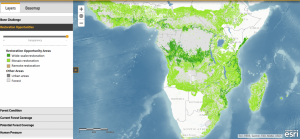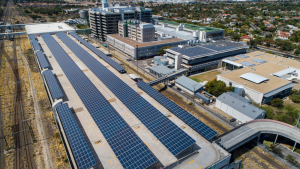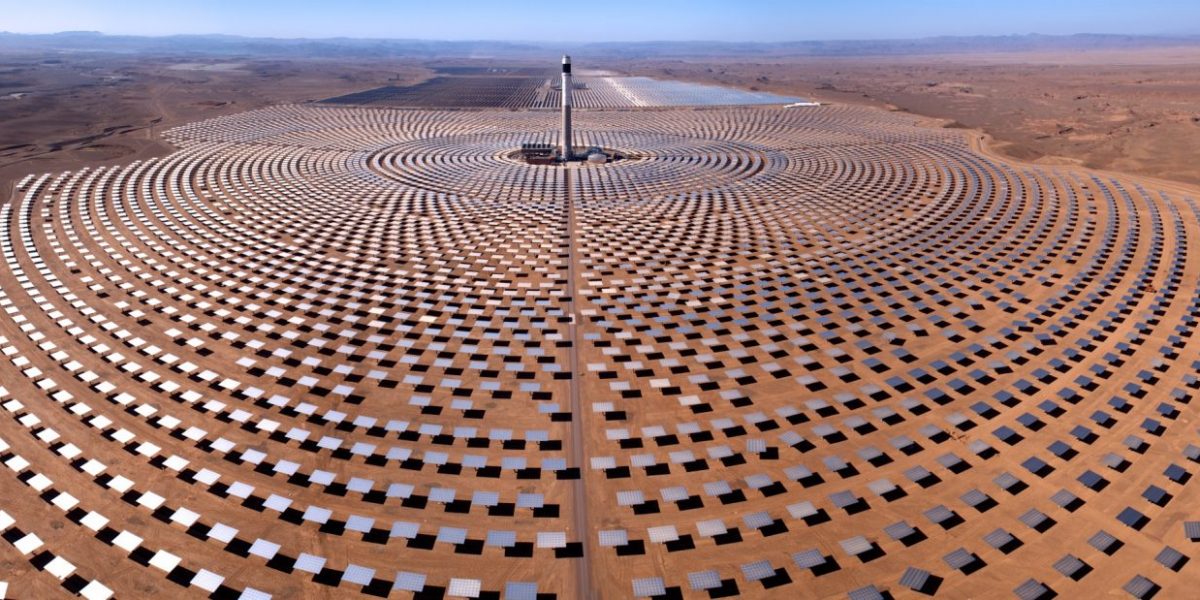In recent years climate change sceptics and the oil & gas and coal lobbies have switched tactics from denying the harm caused by fossil fuels to framing the debate as a choice between economic development and protection of the environment.
For example, “Africa will develop with oil and gas – whether the West likes it or not,” writes NJ Ayuk of the African Energy Chamber in a contribution to the World Economic Forum.
The truth is that accelerating greenhouse gas emissions and biodiversity loss will lead to environmental and social disaster. Setting aside opinions from “the west”, outside of the fossil fuels lobby there are very few Africans willing to accept increased the drought, famine, habitat loss, conflict and economic devastation that further climate change will bring.
However, the argument that we face a choice between the economy and the environment is itself a fallacy. In fact, fighting climate change could be Africa’s biggest business opportunity yet.
Here are 8 reasons and opportunities that show why business and conservation can work together to drive the continent forwards:
1. Energy. Clean Energy is here and it has the potential to transform the continent.
It is noticeable that in recent years the African Development Bank, a major driver of development on the continent, has announced it is “getting out of coal for good” and driven investment towards renewable projects.
Under pressure from shareholders, investment firms and banks are increasingly divesting from fossil fuels.
The signs are clear to see; time is up for businesses that seek to pollute the planet.
President of the African Development Bank, Akinwumi A. Adesina, announced the banks focus on renewables by saying “Africa is rich in energy resources, but poor in energy supply and access. Africa has potential for 11 terawatts of solar energy, 350 gigawatts of hydropower, 110 gigawatts of wind power, and an additional 15 gigawatts of geothermal potential. Yet, the continent generates the same level of electricity as Spain or Belgium.
“With these immense resources, Africa should accelerate investments in technology, innovations, policies and regulations to speed up a renewables revolution.”
It is worth noting decades of fossil fuel dependency have not only failed to lift millions out of poverty, they have also left the entire continent generating the same level of electricity as Belgium.
70% of Africans remain without access to power.
There is no doubt renewables megaprojects can be delivered. There are significant clean energy projects already established across the continent.
The world’s largest solar power development is found in Morroco; The Noor Quarzazate Solar Power Station.

Noor Quarzazate Solar Power Station
Kenya has opened Africa’s largest wind power project, the Lake Turkana Wind Power Project. The project provides reliable, low-cost energy to Kenya’s national grid – approximately 17% of the country’s installed capacity. It was funded by a consortium of African and European companies.
With abundant clean energy sources across the continent, ramping up the production of clean energy and increasing access to electricity is a matter of funding, increasing the number of bankable projects, and de-risking Africa in the eyes of international investors.
Daniel-Alexander Schroth, Principal Energy Specialist at the African Development Bank (AfDB) explained the road forward, saying “We must mobilize capital markets and local financial institutions; create facilities dedicated to scaling up renewable energy investment; and offer technical assistance to national and regional institutions, regulators, and utilities to create an enabling environment and a harmonized regulatory framework.”
Again, it is clear that increased collaboration between financiers, national institutions, and the private sector is vital for climate-friendly solutions to thrive.
2. Land Restoration. Ethiopia’s Green Revolution Can Inspire Regenerative Projects Across Africa.
Ethiopia’s name remains synonymous with the devastating droughts and famines of the 1980s.
It remains highly vulnerable to the effects of climate change with severe drought in 2015 leading to successive failed harvests.
However, modern Ethiopia is by some metrics the world’s fastest-growing economy.
It has also been home to a green revolution which has seen degraded lands restored, food and water security improved, and drought-hit landscapes brought to life.
The World Resources Institute highlights the inspiring story of the people of the Tigray Valley who restored degraded land despite facing a harsh climate and challenging geographic conditions.
By switching to practices that allowed trees and shrubs to naturally regenerate, planting new trees, and improving rainwater management, farmers have restored over one million hectares of land in East and Central Tigray.
In 2000, 61% of Tigray’s population lived below the poverty line. Just over a decade later this figure had dropped to 31%.
A documentary made with the support of the World Resources Institute tells the story of the people regenerating the ecosystem and economy in Tigray;
Ethiopia Rising
Unfortunately, the region continues to be impacted heavily by drought and, more recently, political turmoil and violence. However, the project serves as an excellent example of how collaboration between land communities, NGOs and government can simultaneously restore ecosystems and bring economic benefits. This broad collaboration has ensured that in the face of crisis the local communities remain resilient.
Ethiopia’s government has committed to restoring a further 15 million hectares of land by 2030 as part of its Climate-Resilient Green Economy strategy. Where land is restored, business can thrive. Forest products – from honey to bamboo furniture – add $2.6 billion to the Ethiopean economy each year.
The African Forest Landscape Restoration Initiative aims to restore 100 million hectares across the continent, also by 2030.
Land restoration entrepreneurs are emerging across the continent.
In Kenya, Green Pot Enterprises is restoring land which has been stripped of trees as farmers planted more crops. With no trees, moisture could not be locked in the soil which led to rivers drying up and difficult farming conditions.
Green Pot Enterprises solution is to plant bamboo to restore soils, make rivers flow again and bring cash to local farmers. Bamboo keeps soil in place and carbon stored in the stalks. Farmers sell the bamboo to Green Pot Enterprises who then sell it on to processors to use in the energy, construction and textile industries.
In South Africa, the Baviaanskloof Development Company was established in collaboration with Commonland to regenerate land in the Baviaanskloof region of the Eastern Cape. The Baviaanskloof catchment suffers from decades of wetland degradation, vegetation loss and soil erosion. 70% of the city of Port Elizabeth’s water supply is dependant on the area. Unsustainable farming practices combined with the effects of climate change have created a crisis.
Goat farming in particular had a devastating impact on the landscape due to overgrazing. This project has seen a coalition of partners work with local farmers to take the goats off the hills and use the land to grow lavender and rosemary, crops which are suitable for value addition and processing. In this case, essential oils will be processed from the crops.
Thus far, 11534 hectares of land have been brought under improved regenerative management.
Bakianskloof Project
The South Africa, Kenyan and Ethiopian projects demonstrate the potential to develop profitable businesses while nurturing ecosystems, fighting climate change, providing food and water security and reducing the risk of social unrest and turmoil.
65% of Africa’s land is affected by degradation. Should no action be taken, economic losses to the continent are estimated at 2.48 trillion USD over a 15-year period; losses of 62.4 billion USD per year.
It is estimated that every $1 invested in land restoration provides up to $30 in economic benefits.
The need to act is clear. However, a major challenge remains when it comes to scaling up land restoration enterprises.
Often conservation or land regeneration projects are considered too small to get access to funding from traditional investors. One solution is to bundle projects together to take them to a suitable size for investment and attractive to investors.
More innovative financing solutions are also required. There are relatively few investors that fund companies seeking finance between $20,000 and $200,000 in Africa. This range is too large for microfinance and too small for institutional investors.
The World Resource Institute (WRI)’s Land Accelerator Programme seeks to find solutions to this funding gap by assisting entrepreneurs to pitch impact investors. In order to mobilise funds the WRI developed the Rural Prosperity Bond in collaboration with the Global Innovative Lab for Climate Finance. The fund hopes to $70m globally in land regeneration projects.
While the WRI initiative is very promising, the need for more finance for land regeneration entrepreneurs is clear.
African entrepreneurs are restoring African ecosystems, solving some of the most critical problems facing our planet, and making a profit while doing so. It is time for investors to back them.
AfricaLive Agriculture and Food Special Report >>
AfricaLive Land Special Report >>
3. Finance and Natural Capital. There is already serious money in climate-friendly investing, and 2021 has seen a new $10bn Natural Capital Alliance established.
Tackling climate change could unlock a $23tn investment opportunity by 2030 in emerging markets alone, according to a 2017 report by International Finance Corporation.
Global investors understand some of the best opportunities for return on investment are now in the transition to a more sustainable economic model.
Integrating the value of natural capital is gaining popularity amongst international investors. If wealth is measured in natural capital, there is no poor nation on the African continent.
Natural capital refers to the world’s natural resources, such as forests and rivers. Half of all global economic output depends on it, and there is increased investor interest in preserving natural capital as a solution to reducing emissions, restoring biodiversity, and boosting sustainable economic growth and job creation.
One example is the Natural Capital Investment Alliance recently announced between HSBC Pollination Climate Asset Management, Lombard Odier and Mirova. The fund aims to mobilise USD 10 billion towards natural capital by 2022.
Until recently, natural capital focused projects have been considered too small for serious investors to buy into. Green financiers found their options restricted to investing in renewable energy projects. However, The Future of Nature and Business Report published by the World Economic Forum states that focusing on nature-positive transitions across the agriculture & fishing, construction & infrastructure, and extractives and energy sectors could generate up to US$10.1 trillion in annual business value and create 395 million jobs by 2030.
Philippe Zaouati, CEO of Mirova, says “Protecting natural capital represents a global challenge but also a real opportunity. By mobilising more investors, including pension funds and insurance companies, significant financial assets can be deployed to support those businesses able to generate both attractive returns and tangible environmental and social impacts. Through this approach, the Sustainable Development Goals can be within reach.”
It is vital now that Africa’s business leaders advocate for the continent to be at the forefront of investing in natural capital.
4. Agroforestry. The innovative approach to truly sustainable food production.
Agroforestry is the process where forests and trees are combined with other land uses, including agriculture. This approach allows healthy ecosystems to thrive naturally while the land is also used productively and profitably. Coffee and cashew are popular crops in Africa that can thrive alongside woody plants. Crucially, this approach to agriculture also sequesters carbon from the atmosphere, which slows climate change.
65% of land in Africa is degraded and in need of regeneration.
A report by World Agroforestry shows the benefits of taking action against land degradation outweigh the costs by up to seven times. Developing agroforestry is the ideal action that can be taken, given that it both enriches soil and creates economic benefits.
Globally, there are 1.5 billion hectares of land suitable for restoration through agroforestry.

World Resources Institute map showing, in green, landscape restoration opportunities in sub-Saharan Africa
Each area on the map available for forest restoration is an opportunity to reduce poverty, improve food security, mitigate climate change, and protect the environment.
There are success stories already across Africa. Forestry is a key industry in Ethiopia’s rapid economic growth, and the National Forest Sector Development Program (NFSDP) includes targets to create 630,000 full time jobs in rural areas.
Agroforestry can be introduced to current agricultural operations and offer diversified revenue streams for farmers. In Tanzania, Novel Development cultivates the Allanblackia tree, working with 2500 farmers to diversify their current crops by growing the tree on their land. The seeds from the tree can be used to make an oil similar to palm oil. Unilever has been investing in the development of Allanblackia since 2000 and uses it in a popular margarine sold in France. If the demand for alternatives to palm oil continues to grow, and sustainable growth of Allanblackia can be scaled, entrepreneurs and farmers in Tanzania and Ghana will have access to a multi-billion dollar market.

Gorongosa National Park, Mozambique
In Mozambique’s Gorongosa National Park, the reforesting initiative is being supported by shade-grown coffee and other agroforestry crops. The park was devastated during Mozambique’s civil war and regenerative agriculture is a key part of restoring biodiversity in the park. Matt Jordan, Director of Sustainable Development at Gorongosa says “What is the most exciting thing is that the coffee forests are bringing the biodiversity back.
“Ongoing research projects are proving that only a few years after establishment, these ‘agroforests’ shelter up to 80% of the biodiversity found in the rainforest. That is an amazing result.
“Mount Gorongosa, where the coffee is cultivated, is home to myriad endemic species, including a new gecko to science – and a new bat – along with numerous invertebrates.”
Agroforestry provides a clear opportunity to restore degraded lands in Africa while driving economic growth. The challenge facing the sector often involves the complexity of meeting the needs of multiple and diverse stakeholders from smallholder farmers to buyers and multinational companies.
A further challenge is the division between agriculture, forestry and climate change at a policy level. Governments must shape policies and facilitate investments which provide returns on natural capital. Understanding the role of agroforestry is vital to this.
AfricaLive Forests Special Report >>
AfricaLive will be interviewing the leaders, entrepreneurs and activists involved in the regeneration and conservation of Africa’s forests. Subscribe to the email newsletter to hear first-hand stories of how projects were funded, lessons learned, goals achieved and future opportunities in agroforestry and conservation.
5. Industrialisation. Climate Friendly investments can catalyse Africa towards emerging as a green manufacturing giant.
Investments into implementing green technologies could also drive the industrialisation and manufacturing revolution African leaders have spent years hoping to kickstart.
African countries can not compete internationally when it comes to the type of low-cost manufacturing seen in Southeast Asia. Nor should they, the planet does need more cheap and disposable goods which come with a low price but high environmental cost.
An ambitious vision for the continent would see it manufacturing the technology required to drive a clean energy revolution.
Ngozi Okonjo-Iweala, former Managing Director of the World Bank and former Nigerian finance minister, wrote in the Financial Times, “African countries could also capitalise on opportunities to get more involved in the production of low-carbon technology. Rather than importing solar panels and wind turbines from elsewhere, Africa can establish itself as a green manufacturing giant. We shouldn’t let people just sell us items that we are well-positioned to produce ourselves.
“Instead, we can lead in developing and producing the clean energy solutions we need.”
It is an ambitious plan. However, it is worth noting a Kenyan company, Solinc, has been manufacturing solar panels for the regional market since 2011.
Scaling up such operations is possible, but again only with the appropriate support from financiers and policymakers.
Speaking to AfricaLive, Prof. Nicola Kleyn, Dean of the Gordon Institute of Business Science, warned of a missed opportunity in Africa in relation to new technologies, saying “If we are not alert to the way that technology is being rolled out globally, then in Africa we will find ourselves only being consumers of these technologies.
“That would represent a missed opportunity to be part of the global value chains that are associated with actually producing and delivering these technologies.”
It is clear this ambitious vision of Africa’s future requires visionary leadership at the top of financial and corporate institutions, collaboration across sectors and partnership with higher education and government institutions.
As new technologies shape how we do business, grow our food, and power our communities, African countries have a great chance to transform their manufacturing output.
6. Green Building. The huge growth market in sustainable buildings.
The Green Building Council defines a green building as a building that, in its design, construction or operation, reduces or eliminates negative impacts, and can create positive impacts, on our climate and natural environment. Green buildings preserve natural resources and improve our quality of life.
Green buildings make good business sense. Green buildings achieving the Green Star certification in South Africa have been shown to save on average between 30 – 40% energy and carbon emissions every year, and between 20 – 30% potable water every year, when compared to the industry norm.
The principles of green building became mainstream over the past decade as engineers, designers and architects looked to reduce emissions and running costs.
The covid-19 crisis has moved green building even further up the development agenda.
Globally, the construction and engineering sector has been in crisis throughout the pandemic. The focus now is on kickstarting a “green recovery” to get the global economy back on its feet while building sustainably.
Air quality and the health of workers and building residents is also now a pressing concern.
There is huge job creation potential in the refurbishment of buildings to improve energy and water efficiency for cost savings and to improve indoor air quality for health benefits.
Lisa Reynolds of The Green Building Council of South Africa called for the industry to embrace a green recovery, saying “As we emerge from lockdown, we are in for a tough time for a while, but it is an ideal time to think innovatively and drive a green recovery dealing with the persistent threat of climate change.
“Embrace a green recovery and help us create healthier, resource-efficient and meaningful spaces in the built environment that respond to climate-related challenges.”

Old Mutual, South Africa
Demonstrating a track record in delivering green building projects is becoming essential to work on major developments across the continent. Companies such as Old Mutual in South Africa have invested heavily in ensuring their headquarters achieve the highest ratings in Green Star certification. The Old Mutual Mutualpark includes 3600 solar panels and on-site wastewater treatment plant.
Furthermore, due to the COP21 Agreement and the United Nations’ strategy to channel funding into promoting low carbon growth in Africa, property developers could start to tap into green funds to co-fund their green building developments.
It is a time for innovative solutions which can drive wider economic growth too. The production of steel and concrete is estimated to create 16 per cent of carbon dioxide emissions. Decarbonising the construction industry is a pressing global problem. In bamboo, African countries have access to a material that can be grown sustainably and reduce, a least in part, the industry’s reliance on steel and concrete.
Darly Mayers, joint-CEO of Investec Property Fund summarised the challenge ahead, saying “The environment is a huge issue globally and I suspect that implementing the range of solutions feels quite daunting to business leaders who don’t really know enough about where to deploy impactful spending and so they freeze. It should not be complicated, but it does feel that way. I suspect that there is a disconnect between the environmentalists as forerunners and big business. Somehow that has to change.”
Bridging that gap between environmentalists and business leaders is not only vital for the environment, it is also the key to building sustainable, profitable and innovative African companies.
7. Entrepreneurship. Green Business Incubation Hubs Are Emerging. Higher Education Is Playing a Role in Driving Innovation.
African Leadership University is currently incubating 8 projects that seek to go “beyond tourism” and create sustainable business models for conservation areas. The project highlights that few sustainable business models that protect ecosystems have been developed outside of the standard eco-tourism model.
The project applications highlighted the wealth of potential in combining conservation and entrepreneurship. Projects that will be developed as part of ALU’s incubation hub include online teaching, microfinance for forestry, virtual wildlife interaction, blockchain solutions for donors, sustainable agriculture and food processing.
Researchers at North-West University in South Africa have identified several opportunities for green businesses and products to emerge including using nanotechnology with traditional medicinal plants and harvesting mopane worms and insects as an eco-friendly food source.
University leaders who have spoken to AfricaLive have been unanimous in calling for increased collaboration between business and universities in order to implement sustainable and profitable business solutions.
Africa’s start-up space is thriving but greater support is needed for entrepreneurs to scale their businesses. Securing funding for the “missing middle” – those projects considered too big for microfinance and too small for banks or institutional investors – is one immediate step that must be taken.
8. We invest now or we will pay much more later.
Good business is about mitigating risks and reducing threats.
The cost of inaction on the environmental challenges we face is simply too high for government or business to consider it as a viable option.
Costs from failure to dramatically slow the rate of climate change include direct costs (physical losses from extreme weather events, wildfires, rising sea levels), indirect costs (weaker growth, lower asset values and returns), and the cost of uncertainty (the investor premium paid for new risks and volatility).
These are not abstract projections on future growth, they are immediate risks that are already impacting the profitability and survival of businesses across Africa. Action must be immediate.
Rising deforestation of the Congo Basin is likely impacting rainfall across the Sahel region, leading to drought in Ethiopia and Somalia. Continued deforestation will lead to the continent becoming hotter and drier with water and food supplies impacted from Nigeria to Tanzania. Each hectare of forest lost can lead to resource depletion and business losses far and wide.

Failure to protect the Congo Basin would have knock-on effects across the continent
Cape Town was plunged into crisis in 2017 as the city faced the prospect of water supplies running out. The water crisis resulted in the loss of 37,000 jobs in the Western Cape and an estimated 50,000 people being pushed below the poverty line due to job losses, inflation and increases in the price of food. The agriculture sector suffered losses estimated between US$400 million and $1bn.
Investing in sustainable agriculture and reducing emissions can allow us to step back from the brink of ecological disaster.
Each business decision that negatively impacts soil health, carbon emissions or resource management will have far-reaching consequences. It is time for each and every investor, entrepreneur and company operating in Africa to make the case for a business approach to environmental sustainability.

